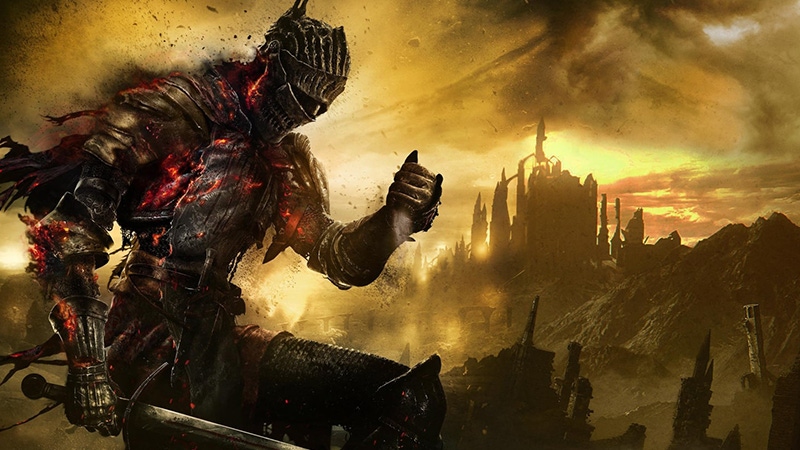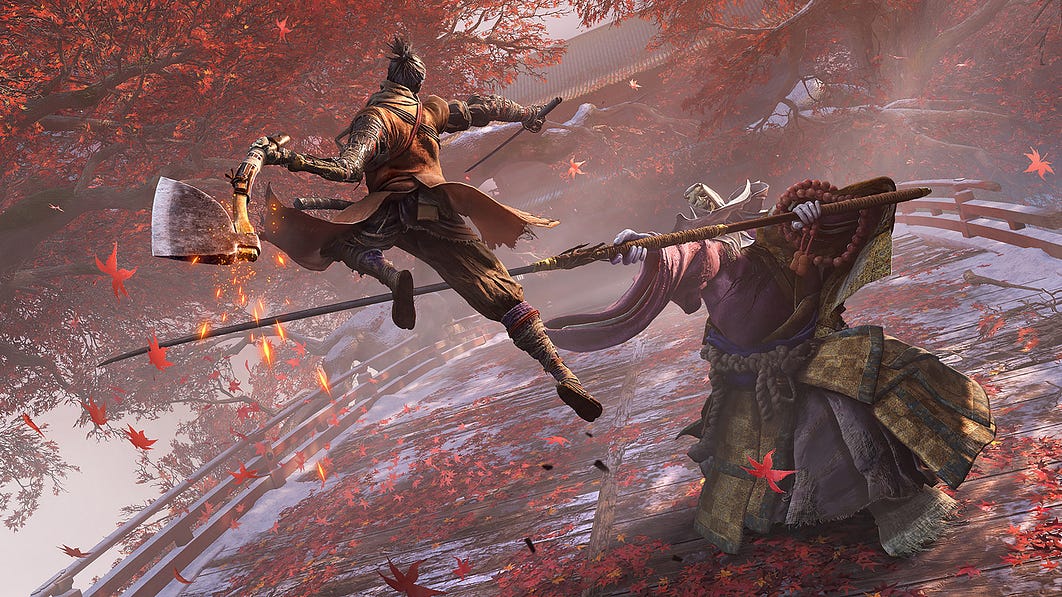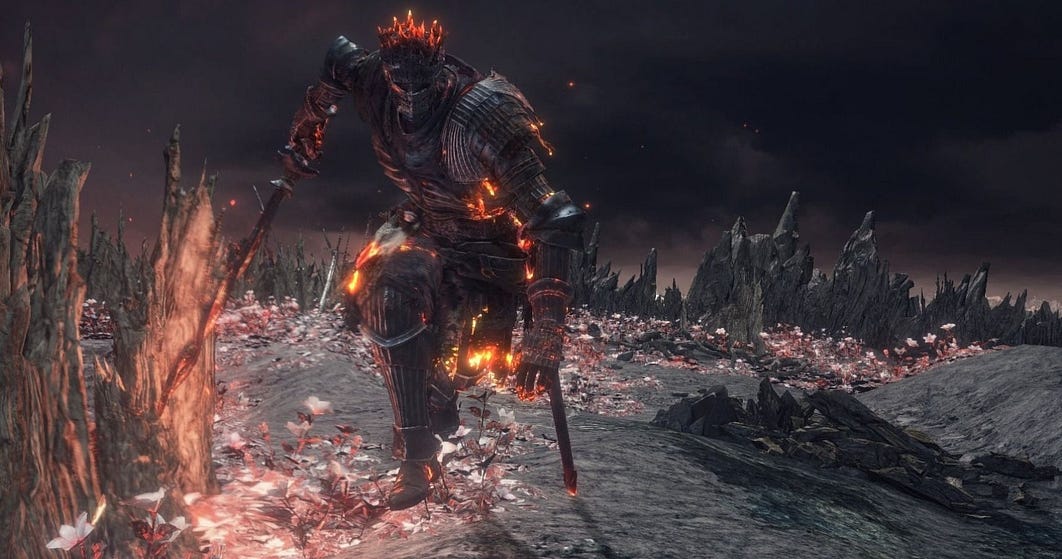Trending
Opinion: How will Project 2025 impact game developers?
The Heritage Foundation's manifesto for the possible next administration could do great harm to many, including large portions of the game development community.

Featured Blog | This community-written post highlights the best of what the game industry has to offer. Read more like it on the Game Developer Blogs or learn how to Submit Your Own Blog Post
Learning how to spot pain points and areas to improve with approachability can be a tough skill to learn, and for today, I'm going to apply that to one of the hardest games to nail down in this regard -- Dark Souls and soulslikes.

I got into a bit of a heated argument lately on Twitter when it came to understanding the issues of accessibility, UX, and game design in a recent post. The point I was trying to make was how accessibility features by themselves cannot be used to try and fix pain points in a game’s design or core gameplay loop. For today’s post, I’m going to try and explain a “simpler” concept -- I’m going to fix Dark Souls.
If there is the perfect encapsulation for the problem when it comes to talking about UX, the core gameplay loop, approachability, and accessibility in a videogame, Dark Souls would be the poster child for it. Every discussion about trying to make the game approachable goes like this:
“Dark Souls is too hard”
“No, it’s not, git gud”
“Dark Souls needs an easy mode”
“No, it’s a game that rewards learning its systems, git gud”
And that repeats on an endless loop. Both arguments are missing the bigger picture about the experience of the game, and more specifically, what’s stopping someone from playing. When I spoke with Steven Spohn from Ablegamers on the topics of accessibility features in games, he laid out some very good points. Everyone wants to be able to experience a game and defeating a boss that is moving 3 times slower can be just as thrilling for someone who can’t easily use a gamepad when compared to someone fighting that boss at normal speed.
Accessibility options like support for additional gamepads and controller types, colorblind mode, UI text increase, and so on, should be in every videogame as the bare minimum. However, and the point I was trying to make in the previous post, those options aren’t enough for retention and don’t correct pain points. Saying your game is “accessible” but at the same time, leaving in or not understanding the pain points of a game, doesn’t make your game accessible. Every game’s design and core gameplay loop is different, and that requires different attention to detail when it comes to approachability. Solid approachability elements improve a game for everyone and can allow multiple skill sets to enjoy and experience a gamein their own way.
For everyone who says that Dark Souls needs an easy mode, they often just stop with that statement without going into an explanation as to what that means. And herein lies the complexity of this topic — What makes Dark Souls difficult, and how do you improve that for everyone?” Changing stats around for an “easy, medium, and hard” difficulty doesn’t address what stops someone from playing. And here’s the interesting point about Dark Souls, it is in fact one of the more approachable games on the market without any difficulty modes. And before anyone tries to paint me as a fanboy, the proof is in the completion rate — with 26% of the consumer base beating the game on Steam, and yes, that is actually on the higher side for most videogames.
However, and the point of the piece today, is that the game does have noticeable churn. When I spoke with TomoMoriwaki, we discussed that players want to feel a sense of progress, whether that’s by beating a game on the hardest difficulty or just fighting one enemy. They need to know that there is a path forward, and if they lose that motivation, or don’t see an option, they’re done. With Dark Souls, it is a game where the difficulty is more about the player’s own abilities and skill set, it’s why the skill ceiling doesn’t go that much higher than the skill floor.
Conversely, this is why it’s also hard to have discussions about the pain points and difficulty of the game. For someone, they can beat the entire first quarter of the game deathless with no armor and find the game boring; someone else could get stuck in the tutorial with a fully armored character and just stop playing. People who stick with Dark Souls and can learn its design will typically go further into the game, the problem is figuring out a way to reduce the churn and attempt to get more people past the early rough patches.
The goal isn’t to achieve 100% retention, that’s impossible, but to figure out if there are aspects that can be improved that either retain more people or reduce pain points for those that want to experience the game. The point is to provide an experience that allows more people to play the game, and to hopefully reduce the spikes in churn. If we can reduce a 30% churn rate in an hour to even just 25%, that not only allows more players to experience the game, but hopefully will get more people past those hurdles, and maybe even improve the playability of the game for everyone else.
Remember: Difficulty is in the eye of the player. At this point, playing a soulslike is my relaxing game, and trying to play Total War: Three Kingdoms is like trying to perform heart surgery while climbing Mt. Everest. If someone wants to experience a game but do it in a way that works for them, either making it easier or harder, there should not be any problems there.
It’s time for a little dissection, as I want to talk about areas where I feel Dark Souls, and by extension souls likes, could be losing players. Before I begin, I want to clarify that what I’m talking about does not make Dark Souls “bad” or “unfun,” but possible areas that are stopping people from getting into the game and making them part of the churn rates. These are aspects that could be optionally tweaked to provide an easier experience, while still letting someone play through the game.
Dark Souls is not the fastest soulslike on the market, the current king of that would be Nioh, but combat speed is one of the major stumbling points for people not accustomed to action games or have problems reacting fast in a game. Given the methodological approach needed to play the game, and more specifically learn it, having the option to slow down the combat speed for people who need it would be helpful both for accessibility and approachability.
Parrying/countering is one of the more advanced elements in any soulslikes. In some of them, this could be a handy feature to make combat easier; in others, it could be required for certain enemies and bosses to stand a chance. It’s also designed to be very risky compared to blocking which mitigates some damage. The entire risk/reward is that do you punish an enemy for attacking or do you take full damage if you miss?
Learning to do this at the start of a game can be difficult. Not only can failing this end up getting your character killed, but you also have different rules regarding timing for every game on the market. A feature to explicitly increase the parry windows for people who may need it would also give them the chance of getting more comfortable with the design. The reason why I say “explicitly” is that some soulslikes have options with different timing windows for parrying, but it’s not really spelled out unless you know what you’re looking for.
This is where I feel I’m going to have either the most pushback or support over for this list. Combat tells are essential in any action game — the player needs some indication as to how to respond to a threat. Every action game on the market treats this differently. Some games alert you to any attack, and the alert itself ends with the attack going off. Other games alert you, but then you need to read the animation for the actual tell.
For titles with different kinds of attacks, it’s considered customary to have tells for “unblockable” attacks, or those that require a specific counter. A good alert system is one of the most important approachability points, as advanced players can attune themselves without it, but this can crush new players if not done right.

combat warnings and tells make it easier to read the combat system
As an example, The Surge allowed players to dodge attacks based on different movements, but the game did not alert the player as to what movements were required. In The Surge 2, the system was evolved to let players know what attack was coming and how to properly dodge it.
For this option, this would be a way of turning on more explicit warnings for players to keep track of. Like other action games or Sekiro, the player could get a visible indicator when the enemy is going to attack, as opposed to just reading the animation tell. This would also have the effect of making it easier to learn parry windows, as the player can be immediately notified when to try and parry.
Healing, as anyone who plays a soulslikes can attest to, is a major aspect of the difficulty of these games. The more you can heal/faster you can heal, the longer you can sustain yourself in a fight. This is why healing upgrades to your eastus are sought after for a lot of players. In combat, one of the big things you need to learn is how to time when to heal, and incorrect timings has been the cause of death for lots of players.
Conversely, this is one of those points that shows off expert players, with many barely needing to heal, or even attempt “no-hit” runs. For new players, eastus use can be another pain point, both in its use and the limitations at the start. I would propose giving the option to turn on more eastus uses per bonfire at the start, possibly even infinite for someone who really needs it.
Another option would be to have a toggleable that lets the game automatically take one of the eastus uses when the player’s health drops below the healing rate, in turn, making healing automatic. This would also help approachability for new players by removing one additional button press that they would need to remember and compensate for during play.
If point #3 doesn’t get me in trouble, then this one certainly will. The Dark Souls punishment is often praised by fans as a way of adding tension and risk to the play, but it’s also a major pain point for new players. Further up, I mentioned how Tomo, and I talked about player motivation — someone always needs to feel like they’re moving forward. Punishment systems will always take away something from the experience, most often time spent playing.
Sometimes, it’s not the actual punishment that hurts someone, but knowing that there is a punishment on failure that stops them from even trying at the first place. This one is an easy fix, but a controversial one, and that is a toggle to turn off the mechanic of losing your souls when you die. I would also go one step further and have the option for the player to just restart the fight instead of having to return to the bonfire and get back to it.

The punishment of losing is sometimes enough for people without the added weight of losing progress
When it comes to hard games and sections, you want the player to always be able to quickly get back to the point they need help with and practice that. Giving people the chance for an instant restart doesn’t minimize the difficulty of the fight but allows them to focus only on the fight and nothing else. I would even go a step further and say that on restarting the fight, any consumed resources should also be restored as this was one of the more annoying aspects of Bloodborne.
The combat system of any soulslike is built on one-on-one fights and tends to heavily break towards the side that has the numbers advantage. Therefore coop is such a big deal and a huge weight off someone’s shoulders when they’re getting help. This is often why coop requires more hoops to go through and that the souls games don’t have an easy-to-use multiplayer system.
For people who haven’t played, players who haven’t been killed can summon those who are in soul form to aid them in exchange for getting a free revive and bonus souls. Players in soul form can set up markers on the ground for people to use to summon them, with the majority either at the start of an area or at the boss fight.
The difference in tone and play in single vs. multiplayer coop is huge. One of the funniest moments in Dark Souls 2 for me was when I joined up with two of my friends and we ran through the opening of the game as a three-man party. The problem is that Dark Souls by its very design is not set up for easy multiplayer play, due to the as-for-mentioned combat system, and we had to do some very specific coordination to get it to work.
My solution here is very simple, give players who want the option for a dedicated “buddy” to always have it in the form of an AI helper. I could imagine the experience being loosely like the game Dragon’s Dogma by Capcom, which was entirely built on you having a party of AI helpers with you throughout the game. I would also make the multiplayer connect system easier and build in safeguards to avoid griefers if people want that option.
This one is a minor point, but if I’m going through all the areas where the game can lose players, then I have to hit it. For the uninitiated, figuring out what gear to wear and applying stat points can be a little obtuse. This point is just pure UI and making things a little clearer to players in terms of how weight works, armor/resistances, and applying skill points.
At the end of the day, no matter the accessibility, approachability, and UX work done to a game is going to make it perfect. There are people who will turn on a game, play for 30 seconds, say the game is not for them, and then turn it off and never return, and that is perfectly acceptable. The goal is to get the people on the fence — those that are interested in the game but feel intimidated by the learning curve or difficulty to start playing or get past those initial hurdles.
They may turn on every option and play the easiest possible setting, they may find themselves turning things off as they become more accustomed to the game, no matter what, how they play the game has no bearing on my experience. Speaking as someone who plays hardcore games, who typically plays on the hardest setting as their default, I have personally gotten fed up with the response to UI/UX suggestions being “Well I don’t want it, so the developers shouldn’t put it in.” If you don’t want to use assist features or play the game an easier way, that’s fine, then don’t use them and pretend like they don’t exist. In Hades, I never touched God mode, just as many people never touched Hell difficulty.
For people who do want to use these features, they have no impact on how someone else is playing a game, and before someone leaves a comment, I’m talking specifically about single-player games. This kind of arbitrary gatekeeping is one of the biggest reasons why niche genres remain niche, and how studios find themselves with fewer consumers interested in their games. UI/UX improvements to a title should never be met with scorn, insulting people who use them, or the lack of them as a form of posturing.
Again, and I can’t stress this enough: Difficulty is not a form of good game design. There is a difference between challenge and difficulty and making your game intentionally difficult because of issues that create pain points is what drives people away from games. It doesn’t matter how “challenging” or how “accessible” a game is if it loses more than half the consumer base in less than an hour, then something is not keeping people interested in it.
If you enjoyed my post, consider joining the Game-Wisdom discord channel. It’s open to everyone.
Read more about:
Featured BlogsYou May Also Like